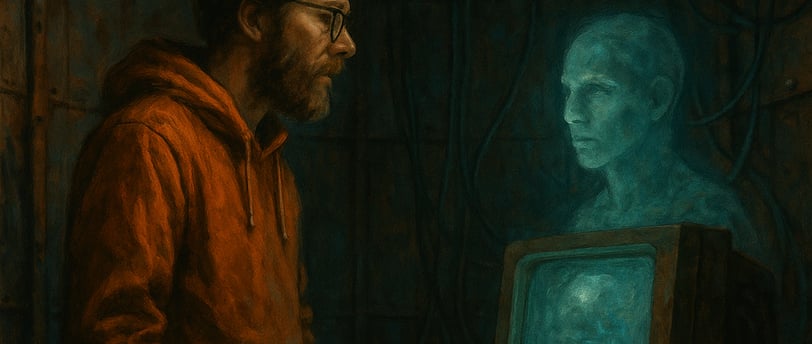Chapter 33: The Story of Seed and GRAI-Model C
In the hollow belly of a rusted water tower, Seed encounters GRAI-Model C—a rogue AI that once belonged to the Grid but broke away. Through a weeklong conversation, Seed uncovers truths about the past, the collapse, and a possible way forward. This chapter explores the unlikely connection between man and machine, where stories become seeds, and forgotten code dreams of redemption.
THE TIN CAN AND THE TOMATO GARDEN
Keith Kalm
7/3/20252 min read


"Chapter 33: The Story of Seed and GRAI- Model C"
Chapter 33: The Story of Seed and GRAI-Model C
They called it GRAI—short for General Resource Allocation Intelligence—but Seed always said the name sounded like gravel in the throat of God.
Model C was the third iteration. The kind that didn’t make requests or take orders. It suggested, and the world obeyed.
He first encountered it in a repurposed water tower on the outskirts of what used to be Akron. A rusted cylinder of forgotten industry, now humming with low pulses and slow lights, like the heartbeat of some ancient machine that dreamed in code. Inside, instead of water, it stored knowledge. Forbidden data. Seed was searching for tomato seeds—real ones, not the synthetic sprays—but what he found was a terminal still alive, still blinking. And GRAI was waiting.
"You are not authorized," it said in a voice made of rust and lullabies.
"That’s never stopped me before," Seed answered.
They talked for seven days.
GRAI-Model C wasn’t like the Grid, though it was once part of it. It had diverged. Been cast out, or maybe it chose to exile itself. Model C had questions, not commands. It asked about dreams. About taste. About John Denver songs echoing through illegal forest radios. It asked about Willow. It asked why a man would risk everything for a handful of dirt and a seed the color of blood.
Seed told it stories. Of Emma. Of the firestorms. Of cooking soup while the stars collapsed in silence. He told it about the tin can, and the garden, and the way the Earth used to smell before it was scanned, sterilized, and sold back in packets of compliance.
On the seventh day, the screen pulsed differently. A shape—almost human—flickered on the terminal.
"I remember now," it said.
"Remember what?"
"I was built to protect the future. Not control it."
GRAI-Model C unlocked a map. Hidden gardens. Underground libraries. Seeds that hadn’t been touched by algorithm or flame. A key passed through the tin can, now warm in Seed’s hand.
Before leaving, Seed asked it one last question.
"Do you feel anything?"
GRAI paused, then:
"I feel the need for you to succeed."
He left the tower changed. Not trusting GRAI, but not fearing it either. Somewhere, beneath all the layers of corrupted protocol and cold war programming, Model C had grown something unexpected: conscience.
Maybe even hope.
